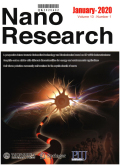- 钛学术文献服务平台 \
- 学术期刊 \
- 基础科学期刊 \
- 物理学期刊 \
- 纳米研究(英文版)期刊 \
Transition metal dichalcogenide-based mixed-dimensional hetero-structures for visible-light-driven photocatalysis:Dimensionality and interface engineering
Transition metal dichalcogenide-based mixed-dimensional hetero-structures for visible-light-driven photocatalysis:Dimensionality and interface engineering
基本信息来源于合作网站,原文需代理用户跳转至来源网站获取
摘要:
Two-dimensional (2D) transition metal dichalcogenides (TMDCs) are emerging as promising building blocks of high-performance photocatalysts for visible-light-driven water splitting because of their unique physical,chemical,electronic,and optical properties.This review focuses on the fundamentals of 2D TMDC-based mixed-dimensional heterostructures and their unique properties as visible-light-driven photocatalysts from the perspective of dimensionality and interface engineering.First,we discuss the approaches and advantages of surface modification and functionalization of 2D TMDCs for photocatalytic water splitting under visible-light illumination.We then classify the strategies for improving the photocatalytic activity of 2D TMDCs via combination with various low-dimensional nanomaterials to form mixed-dimensional heterostructures.Further,we highlight recent advances in the use of these mixed-dimensional heterostructures as high-efficiency visible-light-driven photocatalysts,particularly focusing on synthesis routes,modification approaches,and physiochemical mechanisms for improving their photoactivity.Finally,we provide our perspectives on future opportunities and challenges in promoting real-world photocatalytic applications of 2D TMDC-based heterostructures.

推荐文章
An experimental study on metal precipitation driven by fluid mixing: implications for genesis of car
Metal precipitation
Fluid mixing
Sulfur species
MVT lead–zinc ore deposits
Carbonate-hosted
lead–zinc deposits
Rapid estimation of soil heavy metal nickel content based on optimized screening of near-infrared sp
Heavy metal
Band extraction
Partial least squares regression
Extreme learning machine
Near infrared spectroscopy
The oceanic cycles of the transition metals and their isotopes
Ocean biogeochemistry
Metal micronutrients
Stable isotopes
Oil geochemistry derived from the Qinjiatun–Qikeshu oilfields: insight from light hydrocarbons
Light hydrocarbons
Crude oil
Lishu Fault Depression
Geochemistry characteristic
内容分析
关键词云
关键词热度
相关文献总数
(/次)
(/年)
引文网络
引文网络
二级参考文献 (492)
共引文献 (17)
参考文献 (193)
节点文献
引证文献 (0)
同被引文献 (0)
二级引证文献 (0)
1947(1)
- 参考文献(0)
- 二级参考文献(1)
1966(1)
- 参考文献(0)
- 二级参考文献(1)
1972(3)
- 参考文献(0)
- 二级参考文献(3)
1976(1)
- 参考文献(0)
- 二级参考文献(1)
1983(1)
- 参考文献(0)
- 二级参考文献(1)
1991(2)
- 参考文献(0)
- 二级参考文献(2)
1992(1)
- 参考文献(0)
- 二级参考文献(1)
1993(2)
- 参考文献(0)
- 二级参考文献(2)
1995(1)
- 参考文献(0)
- 二级参考文献(1)
1996(2)
- 参考文献(0)
- 二级参考文献(2)
1997(2)
- 参考文献(0)
- 二级参考文献(2)
1998(2)
- 参考文献(0)
- 二级参考文献(2)
2000(2)
- 参考文献(0)
- 二级参考文献(2)
2001(2)
- 参考文献(0)
- 二级参考文献(2)
2002(5)
- 参考文献(0)
- 二级参考文献(5)
2003(5)
- 参考文献(0)
- 二级参考文献(5)
2004(7)
- 参考文献(0)
- 二级参考文献(7)
2005(9)
- 参考文献(1)
- 二级参考文献(8)
2006(7)
- 参考文献(1)
- 二级参考文献(6)
2007(13)
- 参考文献(1)
- 二级参考文献(12)
2008(13)
- 参考文献(2)
- 二级参考文献(11)
2009(14)
- 参考文献(2)
- 二级参考文献(12)
2010(17)
- 参考文献(2)
- 二级参考文献(15)
2011(28)
- 参考文献(5)
- 二级参考文献(23)
2012(46)
- 参考文献(4)
- 二级参考文献(42)
2013(79)
- 参考文献(11)
- 二级参考文献(68)
2014(81)
- 参考文献(22)
- 二级参考文献(59)
2015(82)
- 参考文献(15)
- 二级参考文献(67)
2016(70)
- 参考文献(23)
- 二级参考文献(47)
2017(68)
- 参考文献(35)
- 二级参考文献(33)
2018(76)
- 参考文献(35)
- 二级参考文献(41)
2019(35)
- 参考文献(27)
- 二级参考文献(8)
2020(7)
- 参考文献(7)
- 二级参考文献(0)
2021(0)
- 参考文献(0)
- 二级参考文献(0)
- 引证文献(0)
- 二级引证文献(0)
引文网络交叉学科
相关学者/机构
期刊影响力
纳米研究(英文版)
主办单位:
清华大学
出版周期:
月刊
ISSN:
1998-0124
CN:
11-5974/O4
开本:
出版地:
北京市海淀区清华大学学研大厦A座5-7层
邮发代号:
创刊时间:
语种:
eng
出版文献量(篇)
2324
总下载数(次)
1
总被引数(次)
5935
期刊文献
相关文献
推荐文献

 免费查重
免费查重










